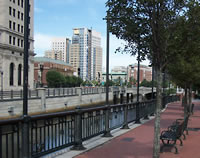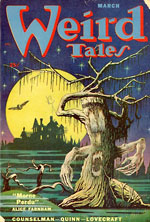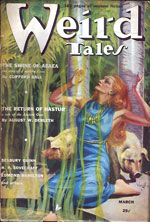Lovecraft’s Providence
The homes and haunts of horror and science fiction writer H. P. Lovecraft
By Nick MamatasNick Mamatas is the author of the Lovecraftian novels Move Under Ground and, with Brian Keene, The Damned Highway. His Lovecraftian short fiction has appeared in the anthologies and magazines Weird Tales, Lovecraft Unbound, New Cthulhu, Dark Wings II, Shotguns vs Cthulhu, and Innsmouth Free Press. His non-Lovecraftian books include an anthology of regional ghost stories co-edited with Ellen Datlow Haunted Legends and the novel Sensation.
“I am Providence,” writer Howard Phillips Lovecraft once declared in a letter to a friend, and that simple phrase became his epitaph. Though H. P. Lovecraft’s short stories and short novels took readers on voyages to hidden cities under Antarctic ice, to millions of years in the past, and to the fantastical Dreamlands, much of his fiction dealt with his New England stomping grounds, and the city of Providence, Rhode Island, he so loved.
Lovecraft was active in the era of pulp magazines; except for the long story The Shadow Over Innsmouth published in an edition of two hundred copies by Visionary Publishing Company in 1936, he saw no books of his work published in his lifetime. Instead he published in the dark fantasy pulp magazine Weird Tales and the science fiction magazine Astounding Stories—that is, when he wasn’t revising fiction for other writers for less than a cent a word, or spending his time corresponding with the many friends he’d made as a member of amateur press associations and as a cult figure among fantasy fans.
Lovecraft’s work has persisted for generations due to his compelling worldview—his gods and monsters aren’t moral arbiters dishing out punishment to the deserving, but symbols of an arbitrary and mechanistic universe—and due to his willingness to let other authors use his fictional creations and settings. Today Lovecraft’s work can be found in many editions, from cheap paperbacks to the 2005 Library of America collection Tales, edited by Peter Straub. Tens of thousands of his letters also survive, and it’s these letters, along with his short fiction, that offer a vision of Providence like none other.
“The city has grown and expanded since Lovecraft’s day, but there are
still lots of weird pockets here and there, and streets that feel like you’ve stumbled back into another period,” said Brian Evenson, author of the novel Last Days and director of the literary arts program at Brown University. Evenson has also worked in the Lovecraftian mode, despite being known primarily as an avant-garde writer. “I think if you’ve read Lovecraft and spend a significant amount of time in the city, you can’t help but feel his lurking presence.”
The presence of Lovecraft is perhaps most obvious at 135 Benefit Street, a private residence that inspired his short story “The Shunned House.” Built in 1763 and in poor condition in his day, Lovecraft was attracted to the house because of its decrepitude and its proximity to the home of Sarah Helen Whitman, a poet once wooed by Edgar Allan Poe. “And yet that house, “ Lovecraft wrote in his tale, “equals or outranks in horror the wildest phantasy of the genius who so often passed it unknowingly, and stands starkly leering as a symbol of all that is unutterably hideous.” Hardly shunned at all these days thanks to both repairs and the tug of Lovecraft’s story, the giant yellow home features signs in French warning tourists and shutterbugs of a chien lunatique. (Last month, it went up for sale.)










